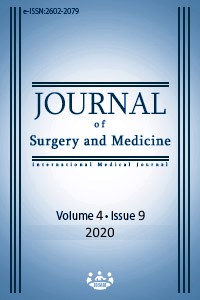Impact of oral immunonutrition on functional outcomes in patients who underwent radical prostatectomy for prostate cancer
Keywords:
Nutrition, prostate cancer, Urinary incontinenceAbstract
Aim: The effect of oral nutritional support on prostate cancer (PCa), especially the functional outcomes, has been severely questioned. We present the results of a controlled trial to determine the effects of oral nutritional support on functional outcomes after radical prostatectomy. Methods: This is a prospectively designed, randomized controlled trial to evaluate oncological outcomes in the initial period and functional outcomes in the third and sixth months, but the data were obtained retrospectively. Thirty-six patients who underwent laparoscopic radical prostatectomy performed by a single surgeon between October 2017 and August 2018 were included in the study. Eighteen were started on oral immunonutrition (Oral-Impact, Nestle, 3 × 237 ml per day for seven days at home) in the postoperative period for 6 months and 18 control patients received elemental nutrition support without immune-nutrition components. Results: There were no significant differences in demographic and baseline characteristics between the groups. There was no wound infection, urinary tract infection, urinary extravasation, hem-o-lock clip migration to bladder, urinoma, or infected lymphocele after surgery in either group. Continence rates at the third and sixth months and potency rates (P=0.630, P=0.37, respectively) six months after radical prostatectomy were similar. Despite the similarity in both continence rates, they were numerically in favor of the study group. Conclusion: Immunonutrition is associated with early recovery of stress urinary incontinence (SUI) following radical prostatectomy but there was no association between immunonutrition, postoperative morbidity or infectious complications. However, further clinical trials are needed to confirm these promising results.
Downloads
References
Hu JC, Elkin EP, Pasta DJ, Lubeck DP, Kattan MW, Carroll PR Predicting quality of life after radical prostatectomy: results from CaPSURE. The Journal of urology. 2004;171(2):703-8.
Rodriguez Jr E, Skarecky DW, Ahlering TE, Post-robotic prostatectomy urinary continence: Characterization of perfect continence versus occasional dribbling in pad-free men. Urology. 2006;67:785-8.
Krupski TL, Saigal CS, Litwin MS. Variation in continence and potency by definition. J Urol. 2003;170:1291-94.
Olsson LE, Salomon L, Nadu A, Hoznek A, Cicco A, Saint F, et al. Prospective patient-reported continence after laparoscopic radical prostatectomy. Urology. 2001;58:570-2.
Penson DF, McLERRAN DALE, Feng Z, Li L, Albertsen PC, Gilliland F D, et al. 5-year urinary and sexual outcomes after radical prostatectomy: Results from the prostate cancer outcomes study. J Urol. 2005;173:1701-05.
Muzii VF, Bistazzoni S, Zalaffi A, Carangelo B, Mariottini A. Chronic subdural hematoma: comparison of two surgical techniques. J Neurosurg. 2005;49:41-7.
Zakaraia AM, Adnan JS, Haspani MSM, Naing NN, Abdullah JM. Outcome of 2 different types of operative techniques practiced for chronic subdural hematoma in Malaysia: an analysis. Surg Neurol. 2008;69:608-16.
Ernestus RI, Beldzinski P, Lanfermann H, Klug N. Chronic subdural hematoma: Surgical treatment and outcome in 104 patients. Surg Neurol. 1997;48:220-5.
Tsutsumi K, Maeda K, Iijima A, Usui M, Okada Y, Kirino T, et al. The relationship of preoperative magnetic resonance imaging findings and closed system drainage in the recurrence of chronic subdural hematoma. J Neurosurg. 1997;87:870- 5.
Teasdale GM, Pettigrew LE, Wilson JT, Murray G, Jannett B. Analyzing outcome of treatment of severe head injury: a review and update on advancing the use of the Glasgow Outcome Scale. J Neurotrauma. 1988;15:587-97.
Marik PE, Zaloga GP. Immunonutrition in high-risk surgical patients: a systematic review and analysis of the literature. JPEN J Parenter Enter Nutr. 2010;34(4):378–86.
Weimann A, Braga M, Harsanyi L, Laviano A, Ljungqvist O, Soeters P. et_al. ESPEN guidelines on enteral nutrition: surgery including organ transplantation. Clin Nutr. 2006;25(2):224–44.
Weimann A, Ebener C, Hausser L, Holland−Cunz S, Jauch KW, et al. Leitlinie parenterale ernährung der DGEM: Chirurgie und transplantation. Aktuel Ernaehr Med. 2007;32:114–23.
McClave SA, Lowen CC, Snider HL. Immunonutrition and enteral hyperalimentation of critically ill patients. Dig Dis Sci. 1992;37(8):1153-61.
Senkal M, Mumme A, Eickhoff U, Geier B, Spa¨th G, Wulfert D, et al. Early postoperative enteral immunonutrition: clinical outcome and cost-comparison analysis in surgical patients. Crit Care Med. 1997;25(9):1489-96.
Evoy D, Lieberman MD, Fahey TJ III, Daly JM. Immunonutrition: the role of arginine. Nutrition. 1998;14(7–8):611–7.
Bertrand J, Siegler N, Murez T, Poinas G, Segui B, Ayuso D, et al. Impact of preoperative immunonutrition on morbidity following cystectomy for bladder cancer: a case–control pilot study. World J Urol. 2014;32:233-7.
Gregg JR, Cookson MS, Phillips S, Salem S, Chang SS, Clark PE, et al. Effect of preoperative nutritional deficiency on mortality after radical cystectomy for bladder cancer. J Urol. 2011;185(1):90-6.
Cerantola Y, Valerio M, Hubner M, Iglesias K, Vaucher L, Jichlinski P. Are patients at nutritional risk more prone to complications after major urological surgery? J Urol. 2012;190(6):2126-32.
Hamilton-Reeves JM, Stanley A, Bechtel MD, Yankee TM, Chalise P, Hand LK, et al. Perioperative Immunonutrition Modulates Inflammatory Response after Radical Cystectomy: Results of a Pilot Randomized Controlled Clinical Trial, The Journal of Urology. 2018;200(2):292-301.
Downloads
- 531 861
Published
Issue
Section
How to Cite
License
Copyright (c) 2020 Sinan Çelen, Yusuf Özlülerden
This work is licensed under a Creative Commons Attribution-NonCommercial-NoDerivatives 4.0 International License.
















